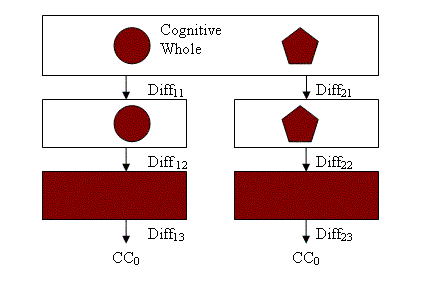
Example in
the above picture: In the cognitive whole there are two figures.
Through differentiation
tree DTA (containing Diff11) we separate context
of one figure,
and through DTB (containing Diff21), we
abstract the
context of other figure (we can’t use notions of circle or pentagon for
determining the figures as such determination is not present at all in
the
figure). DTA and DTB
are different. Both those figures are then determined by same DTX,
containing differentiation by color (Diff12=Diff22),
and
further differentiation of red in the context of determined color (Diff13=Diff23).
So we can say that both figures are same by being determined
as red. So… the contexts determined by DTA and DTB are
same
by DTX. (CC0 is the cognitive context that is
left after
the DTX, to which our will is indifferent)
Here we can see how separate things A and B can be the same thing – it is because their determination (of what they are) is the differentiation tree which is used to determine them in their containing context. So if awareness of the (one and the same) differentiation tree DTX is held while changing the context from CCA to CCB the *both* different contexts are determined as *same one*. And in this model the same differentiation can be held *across* time as differentiations are not *in* time, but can be done and are done on the continuous form of time.
Such thing is possible just in model in which whole containing time on (or “in”) which differentiations are made is first principle. In a “whole exists through the parts changing in time” model (similar to computer model) where comparing would be separate to things being compared, awareness of sameness is not possible, nor “keeping” the same pattern for comparing is possible as it must be stored in some kind of memory and later retrieved. With that the apodictical necessity is gone, what is retrieved can be totally different pattern, a possible consciousness functioning that way, is unable to say that “it is aware” that two things are same.
The same differentiation can be done at two different experiences. In such way *one and the same* thing can be recognized in two different experiences. This fact along with the time as subjective form seems to me set of two things which can be used as basis for solid model of memory, which explains several possibilities. (Of course we would not go into building the whole model here, but present how these principles solve some of possibilities which are present in us)
Such model would explain why we see one thing as a same with the one we recognized before. It is because how that thing is determined (and hence what that thing is to us) and even those differentiations are done at different experiences, those are still *one and the same* differentiation, hence for us it is the same thing.
For example when we smell something, even we could have a lot of experiences from last time we smelled same thing, we think “I know that smell from somewhere.” – For us it is *the same* smell.
Having the smells in mind, it is easy to propose one other assumption about why we tend to remember the smells.
In this kind of model in which things are same not because the cognitive “input” is same but because the experience is determined as same by the same differentiations, it would implicitly follow that if we don’t change the way we differentiate, we can “remember” the same thing even it was experienced “a long time ago” (remember is here in sense that we can recognize the same thing in cognition). Given that the differentiations of smell are generally not changing in the humans, we can make an assumption that is the reason why we can remember some smell even a long time has passed.
On other hand, humans change the way they differentiate visual or auditory experience maybe as a consequence of changing body (or whatever reality “out there” is), maybe as consequence of the needs to differentiate in different ways (we will get to this need later), or maybe because of both. In such way, I as a grown up person would do a different differentiation of a cognitive context containing some person then I did as a child, hence I would not determine that person as *one and the same* - hence I can’t remember him.
It is usually seen that when we say that “A is B”- that subject A is predicate B, it means that B is set and that A is seen as element belonging to that set. So for example “red is color” would mean that there is set of colors and that red is color, by belonging to that set. But as it was noted before it wouldn’t explain, how it is possible to ask “What is that color?”, nor could such model explain why such propositions like “red is color” are apodictically true.So here we come to other possibility question: How it is
possible to have apodictically true propositions?
To answer this one we should show what concepts in our model are, and what is the nature of the proposition.